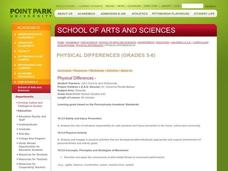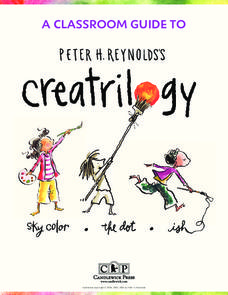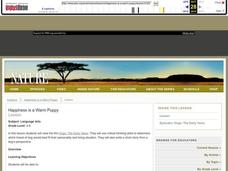American Museum of Natural History
Thinking in the Three Dimensions
Discover different dimensions with paper folding. Pupils first read about zero, one, two, and three dimensions, and then learn about the fourth dimension, time. They then use origami to create models of shapes in three dimensions and use...
Curated OER
One Step at a Time
Learners investigate the customs and habits of other cultures by reading letters from a Peace Corps Volunteer. In this global customs lesson, students discuss how analyzing a culture is similar to analyzing art, no two people see...
Curated OER
Pet Perspective
Discuss point of view through a familiar medium: your pet! Learners write a story from the perspective of their own or the class pet. Prompts such as "My Family" (or "My Class"), "My Day," and "A Day in the Life of a _________" help...
Channel Islands Film
Santa Cruz Island - Visible Thinking Routines
Visible Thinking Routines are designed to help learners deepen their understanding of what they are learning and enable them to communicate their understanding of concepts to others. Individuals adopt one of these routines to use to...
Curated OER
Apple Energy
Ninth graders evaluate the energy associated with the production of five different forms of apple products. They develop a poster to advertise one of the five apple products to the class. Students provide additional examples of consumer...
Curated OER
Diversity
Students access prior knowledge of the five senses and relate to students with disabilities. In this people with disabilities lesson, students research and use a Venn diagram to compare and contrast famous people and their...
Candlewick Press
A Classroom Guide to Peter H. Reynolds's Creatrilogy
Help young readers find, identify, and use their voices with a set of empowering activities based on Peter H. Reynolds' trilogy of books. Sky Color, Ish, and The Dot focus on recognizing moods and treating each other...
Curated OER
New Perspectives
Eighth graders imagine they are getting ready to "take off." They may imagine themselves in any type of aircraft or spaceship. They may then sketch themselves as passengers anticipating this moment.
NASA
Unsung Heroes of Science
Scholars research scientific heroes who haven't been given enough credit for their discoveries. While many are women, there are also men to whom credit is overdue.
Curated OER
Design-A-Room
Students employ art as a means of communication. The meaning of the communication comes out in the design of a unique room that is 3 dimensional. The use of the imagination is encouraged as well as visualization skills.
Curated OER
Finding Science in An American Childhood by Annie Dillard
Students read excerpts from Annie Dillard's memoir, "An American Childhood," with the teacher. They experience opportunities to connect English, science, nature and art together from a new and unique perspective. This approach serves as...
Curated OER
What is a Pest?
Young scholars investigate whether rabbits should be considered pests even though they make good pets. They extend this to determine what, when, and where other organisms are considered to be pests, and examine why the concept of a pest...
Curated OER
Designing Our Own Inventions
Third graders use research from a previous lesson to design their own inventions. In groups, they brainstorm a product they would like to see built and share them with the class. They must explain how each one would serve a purpose or...
Curated OER
Happiness is A Warm Puppy
Students investigate dog breeds and write a short story from a dog's perspective. In this dog research and writing lesson, students watch the film, "Dog: The Early Years. They apply critical thinking skills to determine which type of dog...
Curated OER
Desert Animals (Introduction to Reptiles)
Third graders listen to a story that introduce them to reptiles. They participate in a discussion concerning these desert animals and write from the rattlesnake's point of view.
Curated OER
Battle of New Orleans
Students use the Internet, encyclopedias, and other library resources to discover basic facts about the Battle of New Orleans and the 1768 revolt by French colonists in Spanish Louisiana. They examine two websites that give information...
Curated OER
Save the Earth Day
First graders tellacollaborate with other students around the world sharing their ideas about what earth day means to them. They share ways in which they recycle, reduce and reuse.
Curated OER
Take a Leap!
Eighth graders discuss the flight of the Wright Brothers at Kitty Hawk. They study artwork of various sculptors showing the concept of flight. They write a paragraph and design a papier-mache' sculpture that shows movement.
Curated OER
China's Giant Panda
Third graders read an article called "All About Pandas." In this Panda lesson, students become familiar with the connection of the Panda to Chinese culture. Students recognize that Pandas are endangered. Students complete a...
Curated OER
Would You Believe Your Eyes?
Students study the parts and functions of the human eye. They create dodecagons which are twelve-sided figures with twelve equal angles and share these with the class so that each student can begin to see how many different illusions can...
Curated OER
Nonpoint Source Pollution in Long Island Sound
Students examine and identify the types of nonpoint pollution on Long Island Sound. In groups, they walk the shoreline, collect trash and identify its source. Using that information, they create a variety of graphs of the different...
Alabama Learning Exchange
Straight Line Motion
Students examine gravity, mass, and friction. In this speed and motion instructional activity, students investigate how straight line motion is impacted by gravity, mass, and fiction as they participate in a hands-on activity.
Curated OER
Cartography
Students follow directions to draw a map of an island. They complete the island map adding their own details using symbols and a legend.
Curated OER
How Do Values Shape Conflicts?
Pupils work through conflict. In this conflict resolution lesson, students participate in a simulation that requires them to consider both sides of the whaling issue.























